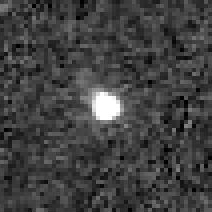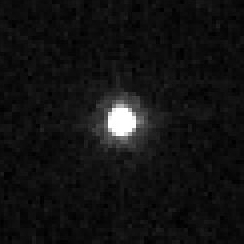Related Research Articles

1998 WW31, is a non-resonant trans-Neptunian object and binary system from the Kuiper belt located in the outermost region of the Solar System, approximately 148 kilometers (92 miles) in diameter. It was first observed on 18 November 1998, by American astronomer Marc Buie and Robert Millis at the Kitt Peak National Observatory in Arizona, United States. In December 2000, a minor-planet moon, designated S/2000 (1998 WW31) 1 with a diameter of 123 kilometers (76 miles), was discovered in its orbit. After Charon in 1978, it was the first of nearly 100 satellites since discovered in the outer Solar System.

(208996) 2003 AZ84 (provisional designation 2003 AZ84) is a trans-Neptunian object with a possible moon located in the outer regions of the Solar System. It is approximately 940 kilometers across its longest axis, as it has an elongated shape. It belongs to the plutinos – a group of minor planets named after its largest member Pluto – as it orbits in a 2:3 resonance with Neptune in the Kuiper belt. It is the third-largest known plutino, after Pluto and Orcus. It was discovered on 13 January 2003, by American astronomers Chad Trujillo and Michael Brown during the NEAT survey using the Samuel Oschin telescope at Palomar Observatory.
(118228) 1996 TQ66 (provisional designation 1996 TQ66) is a resonant trans-Neptunian object of the plutino population in the Kuiper belt, located in the outermost region of the Solar System. It was discovered on 8 October 1996, by American astronomers Jun Chen, David Jewitt, Chad Trujillo, and Jane Luu, using the UH88 telescope at the Mauna Kea Observatories, Hawaii. The very red object measures approximately 185 kilometers (110 miles) in diameter. As of 2021, it has not been named.
(35671) 1998 SN165 (provisional designation 1998 SN165) is a trans-Neptunian object from the Kuiper belt located in the outermost region of the Solar System. It was discovered on 23 September 1998, by American astronomer Arianna Gleason at the Kitt Peak National Observatory near Tucson, Arizona. The cold classical Kuiper belt object is a dwarf planet candidate, as it measures approximately 400 kilometers (250 miles) in diameter. It has a grey-blue color (BB) and a rotation period of 8.8 hours. As of 2021, it has not been named.

(40314) 1999 KR16 is a trans-Neptunian object on an eccentric orbit in the outermost region of the Solar System, approximately 254 kilometers (158 miles) in diameter. It was discovered on 16 May 1999, by French astronomer Audrey Delsanti and Oliver Hainaut at ESO's La Silla Observatory in northern Chile. The very reddish object is a dwarf planet candidate and has a rotation period of 11.7 hours.

471143 Dziewanna (provisional designation 2010 EK139) is a trans-Neptunian object in the scattered disc, orbiting the Sun in the outermost region of the Solar System.
2010 KZ39 is a trans-Neptunian object orbiting the Sun as a detached object in the outer reaches of the Solar System. The object was first observed on 21 May 2010 by astronomers Andrzej Udalski, Scott Sheppard, M. Szymanski and Chad Trujillo at the Las Campañas Observatory in Chile.
(589683) 2010 RF43 (provisional designation 2010 RF43) is a large trans-Neptunian object orbiting in the scattered disc in the outermost regions of the Solar System. The object was discovered on 9 September 2010, by American astronomers David Rabinowitz, Megan Schwamb and Suzanne Tourtellotte at ESO's La Silla Observatory in northern Chile.
(445473) 2010 VZ98 (provisional designation 2010 VZ98) is a trans-Neptunian object of the scattered disc, orbiting the Sun in the outermost region of the Solar System. It has a diameter of approximately 400 kilometers.
1999 TR11, is a resonant trans-Neptunian object from the Kuiper belt, located in the outermost region of the Solar System. The reddish plutino measures approximately 93 kilometers (58 miles) in diameter. It was first observed on 9 October 1999, by American astronomer Scott Sheppard at the Mauna Kea Observatories with the University of Hawaii's 2.2-meter telescope.
(523671) 2013 FZ27 (provisional designation 2013 FZ27) is a trans-Neptunian object located in the Kuiper belt in the outermost region of the Solar System, approximately 570 kilometers (350 miles) in diameter. It was discovered on 16 March 2013, by American astronomers Scott Sheppard and Chad Trujillo at the CTIO in Chile. Numbered in 2018, this minor planet has not been named.
(315530) 2008 AP129 (provisional designation 2008 AP129) is a trans-Neptunian object and possibly a cubewano from the outermost regions of the Solar System, approximately 480 kilometers in diameter. It was discovered on 11 January 2008, by American Michael E. Brown and Megan Schwamb at Palomar Observatory in California.
(523635) 2010 DN93 (provisional designation 2010 DN93) is a trans-Neptunian object from in the scattered disc located in the outermost region of the Solar System. It was discovered on 26 February 2010, by astronomers with the Pan-STARRS survey at Haleakala Observatory on the island of Maui, Hawaii, in the United States. Assuming a low albedo, the object is estimated at 490 kilometers (300 miles) in diameter. It was numbered in 2018 and remains unnamed.
(501581) 2014 OB394, provisional designation 2014 OB394, is a trans-Neptunian object from the outermost region of the Solar System, approximately 260 kilometers (160 miles) in diameter. It was discovered on 25 August 2012, by astronomers with the Pan-STARRS survey at Haleakala Observatory, Hawaii, United States. The weak dwarf planet candidate was numbered in 2017 and remains without a name.
(523674) 2013 MA12 (provisional designation 2013 MA12) is a classical trans-Neptunian object and dwarf planet candidate from the Kuiper belt, located in the outermost region of the Solar System, approximately 340 kilometers (210 miles) in diameter. The cubewano belongs to the hot population. It was discovered on 26 July 2011, by astronomers with the Pan-STARRS survey at Haleakala Observatory, Hawaii, United States.
(523702) 2014 HW199 (provisional designation 2014 HW199) is a trans-Neptunian object from the classical Kuiper belt, located in the outermost region of the Solar System. It was discovered on 30 January 2011, by astronomers with the Pan-STARRS survey at Haleakala Observatory, Hawaii, United States. The classical Kuiper belt object is also a dwarf planet candidate, as it measures approximately 290 kilometers (180 miles) in diameter.
(523684) 2014 CQ23 (provisional designation 2014 CQ23) is a trans-Neptunian object and cubewano from the Kuiper belt, located in the outermost region of the Solar System. It was discovered on 13 March 2011, by astronomers with the Pan-STARRS survey at Haleakala Observatory, Hawaii, United States. The classical Kuiper belt object belongs to the hot population and is a dwarf planet candidate, as it measures approximately 330 kilometers (210 miles) in diameter.
(523687) 2014 DF143 (provisional designation 2014 DF143) is a trans-Neptunian object and cubewano from the Kuiper belt, located in the outermost region of the Solar System. It was discovered on 12 April 2011, by astronomers with the Pan-STARRS survey at Haleakala Observatory, Hawaii, United States. The classical Kuiper belt object belongs to the hot population and is a dwarf planet candidate, as it measures approximately 350 kilometers (220 miles) in diameter.
(495603) 2015 AM281 (provisional designation 2015 AM281) is a resonant trans-Neptunian object in the outermost region of the Solar System, guesstimated at approximately 470 kilometers (290 miles) in diameter. It was discovered on 13 March 2010, by astronomers with the Pan-STARRS survey at Haleakala Observatory, Hawaii, United States.
(505624) 2014 GU53 (provisional designation 2014 GU53) is a trans-Neptunian object and cubewano from the Kuiper belt, located in the outermost region of the Solar System. It was discovered on 8 April 2014, by astronomers with the Pan-STARRS survey at Haleakala Observatory, Hawaii, United States. The classical Kuiper belt object belongs to the hot population and is a dwarf planet candidate, as it measures approximately 330 kilometers (210 miles) in diameter.
References
- 1 2 3 4 5 6 "523645 (2010 VK201)". Minor Planet Center. Retrieved 9 October 2018.
- 1 2 3 4 "JPL Small-Body Database Browser: 523645 (2010 VK201)" (2017-12-20 last obs.). Jet Propulsion Laboratory . Retrieved 9 October 2018.
- ↑ "List Of Transneptunian Objects". Minor Planet Center. Retrieved 9 February 2018.
- 1 2 3 4 "List of Known Trans-Neptunian Objects". Johnston's Archive. 22 July 2017. Retrieved 9 October 2018.
- 1 2 3 Brown, Michael E. "How many dwarf planets are there in the outer solar system?". California Institute of Technology . Retrieved 9 October 2018.
- 1 2 3 4 5 6 7 8 "LCDB Data for (523645) 2010 VK201". Asteroid Lightcurve Database (LCDB). Retrieved 9 October 2018.
- 1 2 3 Benecchi, Susan D.; Sheppard, Scott S. (May 2013). "Light Curves of 32 Large Transneptunian Objects". The Astronomical Journal. 145 (5): 19. arXiv: 1301.5791 . Bibcode:2013AJ....145..124B. doi:10.1088/0004-6256/145/5/124. S2CID 54183985.
- ↑ "Asteroid (523645) 2010 VK201". Small Bodies Data Ferret. Retrieved 9 October 2018.
- ↑ Proudfoot, Benjamin; Ragozzine, Darin (May 2019). "Modeling the Formation of the Family of the Dwarf Planet Haumea". The Astronomical Journal. 157 (6): 230. arXiv: 1904.00038 . Bibcode:2019AJ....157..230P. doi: 10.3847/1538-3881/ab19c4 . S2CID 90262136.
- ↑ "MPC/MPO/MPS Archive". Minor Planet Center. Retrieved 9 October 2018.

